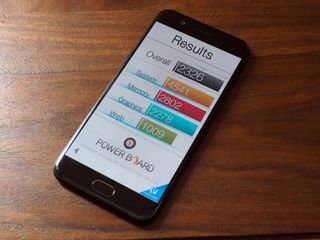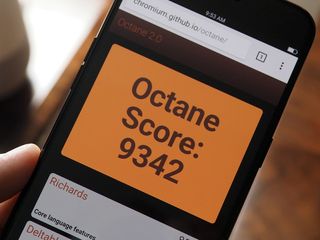Snapdragon 660: Benchmarks, impressions and everything you need to know!

Qualcomm made the switch to the 14nm manufacturing node with the Snapdragon 820, which started rolling out at the beginning of 2016. The company also made the 14nm node accessible to the mid-range segment with the Snapdragon 625, the successor to the Snapdragon 617. The 14 FinFET node allowed for vastly increased efficiency, with the SD625 consuming 35% less energy when compared to the 28nm SD617.
As a result, the Snapdragon 625 turned out to be extremely popular, powering everything from the $150 Redmi Note 4 to the $500 BlackBerry KEYone. Looking ahead to the latter half of 2017, Qualcomm has rolled out key updates to the Snapdragon 600 series with two new chipsets — the Snapdragon 630 and the Snapdragon 660.
The Snapdragon 630 is the direct successor to the Snapdragon 625, offering 30% faster cores, support for Bluetooth 5, a faster LTE modem, USB 3.1 with USB-C, a new ISP, and Quick Charge 4.0.
The Snapdragon 660 is the more interesting of the two, as it is the successor to the Snapdragon 653. The Snapdragon 660 is designed to bring flagship-class performance to the mid-range segment, with Qualcomm rolling out a slew of updates.
The chipset features custom Kryo cores — a first for this segment, a new Adreno 512 GPU, Snapdragon X12 LTE modem with download speeds of 600Mbps and 3x carrier aggregation, Wi-Fi ac with 2x2 MU-MIMO, a Spectra 160 image signal processor, Bluetooth 5, Quick Charge 4.0, and USB 3.1. Qualcomm is touting a 20% increase in performance when compared to the SD653 from the new Kryo 260 cores, and a 30% uptick for the GPU.
Before we delve in, a look at the specs on offer with the Snapdragon 660.
Snapdragon 660 specs

| Category | Snapdragon 660 | Snapdragon 653 |
|---|---|---|
| CPU | Four 2.2GHz Kryo 260 cores Four 1.8GHz Kryo 260 cores | Four 1.95GHz Cortex A72 cores Four 1.44GHz Cortex A53 cores |
| GPU | Adreno 512 850MHz | Adreno 510 600MHz |
| Memory | Dual-channel LPDDR4 at 1866MHz 29.9GB/s | Dual-channel LPDDR3 at 933MHz 14.9GB/s |
| LTE | Snapdragon X12 LTE (Cat. 12) 600Mbps downlink, 150Mbps uplink 3x20MHz CA, 256-QAM | Snapdragon X9 LTE (Cat. 7) 300Mbps downlink, 150Mbps uplink 2x20MHz CA, 64-QAM |
| Wi-Fi | Wi-Fi ac Wave2 Max 867Mbps throughput 2x2 MU-MIMO | Wi-Fi ac Wave2 Max 433Mbps throughput |
| ISP | 14-bit Spectra 160 24MP single, dual 16MP Zero shutter lag, hybrid autofocus, optical zoom | Dual ISP 21MP single |
| Bluetooth | Bluetooth 5 | Bluetooth 4.1 |
| Fast charging | Quick Charge 4.0 | Quick Charge 3.0 |
| Node | 14nm LPP (Low Power Plus) | 28nm HPm (High Performance Mobile) |
There's no information on the underlying ARM core the Kryo 260 is based on, but it's likely Qualcomm is using a semi-custom design, much like what it did with the Kryo 280 on the Snapdragon 835. The core configuration is split into two sectors — performance and efficiency, with the former featuring four 2.2GHz cores and the latter four 1.8GHz cores.
Be an expert in 5 minutes
Get the latest news from Android Central, your trusted companion in the world of Android
The Spectra 160 is particularly interesting, as it enables a lot of camera experiences that have thus far been limited to flagship chipsets. The ISP supports hybrid autofocus, dual rear camera setups (up to 16MP for each imaging sensor), dual photodiode autofocus, smooth optical zoom, and EIS for video.
Snapdragon 660 benchmarks

The OPPO R11 is the first phone to feature the Snapdragon 660, and it gives us an early look at how the Snapdragon 660 fares when compared to the likes of the Snapdragon 652, Snapdragon 835, and others.
AnTuTu
AnTuTu Benchmark
| Device | Overall score |
|---|---|
| OPPO R11 (SD660) | 118525 |
| Smartron srt.phone (SD652) | 78923 |
| Xiaomi Mi 6 (SD835) | 158292 |
| Samsung Galaxy S8+ (Exynos 8895) | 170219 |
| Google Pixel XL (SD821) | 132728 |
| Lenovo Z2 Plus (SD820) | 133341 |
| Moto Z2 Play (SD626) | 68644 |
| Redmi Note 4 (SD625) | 62230 |
Geekbench
Geekbench 4.0
| Device | Single-core | Multi-core |
|---|---|---|
| OPPO R11 (SD660) | 1608 | 5848 |
| Smartron srt.phone (SD652) | 1425 | 2815 |
| Xiaomi Mi 6 (SD835) | 1919 | 6095 |
| Samsung Galaxy S8+ (Exynos 8895) | 1996 | 6441 |
| Google Pixel XL (SD821) | 1604 | 4162 |
| Lenovo Z2 Plus (SD820) | 1692 | 3239 |
| Moto Z2 Play (SD626) | 911 | 4594 |
| Redmi Note 4 (SD625) | 843 | 2754 |
Basemark
Basemark OS II
| Device | Overall score |
|---|---|
| OPPO R11 (SD660) | 2326 |
| Smartron srt.phone (SD652) | 1535 |
| Xiaomi Mi 6 (SD835) | 3424 |
| Samsung Galaxy S8+ (Exynos 8895) | 2597 |
| Google Pixel XL (SD821) | 2340 |
| Lenovo Z2 Plus (SD820) | 2127 |
| Moto Z2 Play (SD626) | 1221 |
| Redmi Note 4 (SD625) | 1082 |
Octane 2.0
Google Octane 2.0
| Device | Overall score |
|---|---|
| OPPO R11 (SD660) | 9342 |
| Smartron srt.phone (SD652) | 8683 |
| Xiaomi Mi 6 (SD835) | 11658 |
| Samsung Galaxy S8+ (Exynos 8895) | 8076 |
| Google Pixel XL (SD821) | 8032 |
| Lenovo Z2 Plus (SD820) | 6364 |
| Moto Z2 Play (SD626) | 4828 |
| Redmi Note 4 (SD625) | 3887 |
GFXBench
GFXBench GL Benchmark
| Device | Car chase | Manhattan |
|---|---|---|
| OPPO R11 (SD660) | 8.6 | 15 |
| Smartron srt.phone (SD652) | 5.9 | 9.9 |
| Xiaomi Mi 6 (SD835) | 22 | 37 |
| Samsung Galaxy S8+ (Exynos 8895) | 25 | 41 |
| Google Pixel XL (SD821) | 19 | 30 |
| Lenovo Z2 Plus (SD820) | 19 | 32 |
| Moto Z2 Play (SD626) | 3.5 | 6.5 |
| Redmi Note 4 (SD625) | 3.4 | 6.2 |
3DMark
3DMark (Sling Shot Extreme)
| Device | Overall score |
|---|---|
| OPPO R11 (SD660) | 1354 |
| Smartron srt.phone (SD652) | 900 |
| Xiaomi Mi 6 (SD835) | 3321 |
| Samsung Galaxy S8+ (Exynos 8895) | 2575 |
| Google Pixel XL (SD821) | 2655 |
| Lenovo Z2 Plus (SD820) | 2347 |
| Moto Z2 Play (SD626) | 469 |
| Redmi Note 4 (SD625) | 455 |
The benchmarks show a performance increase across the board for the Snapdragon 660, with the chipset coming close to last year's flagship SoCs. That's consistent with what I've seen in the two weeks I used the R11. There's a noticeable uptick in battery life as well from the likes of the Snapdragon 650/652/653.
For now, the main issue with the Snapdragon 660 is its availability, or lack thereof. The OPPO R11 is limited to Asia, and won't be available outside of the region anytime soon. More devices powered by the Snapdragon 660 should be rolling out in Q4, and if recent rumors are any indication, the Moto X4 will be the first phone to be powered by the Snapdragon 660 in the U.S.
Once it becomes mainstream, I think it will quickly become one of the most popular mid-range chips on the market; from a CPU perspective, it benchmarks close to the Snapdragon 835 in some respects, and handily beats every other budget SoC on the market. Lots to look forward to!

Harish Jonnalagadda is a Senior Editor overseeing Asia at Android Central. He leads the site's coverage of Chinese phone brands, contributing to reviews, features, and buying guides. He also writes about storage servers, audio products, and the semiconductor industry. Contact him on Twitter at @chunkynerd.
